GIRONA, SPAIN - I arrive in this colourful city just as townsfolk are setting up a giant stage for an evening rock concert. A festive mood hangs over the Rambla — the main street that runs parallel to one of the four rivers that snake through Girona — and Aicard, my local guide, directs my attention to the balconies overlooking the busy street.
“My mother lives in that apartment and I’ve invited some friends over to listen to the concert from our balcony. I hope she has bought enough food,” worries Aicard just as an elderly woman appears on the balcony and blows him a reassuring kiss.
“Awe, I have nothing to worry about,” says Aicard, who now turns his attention to showing me this remarkable Catalan city with the rich history that stretches back thousands of years — it was part of the Holy Roman Empire at one time.
“Girona is one of the most popular cities in all of Catalan,” boasts Aicard, who qualifies as its “proudest” citizen. “In fact, Girona consistently wins the annual country-wide poll of preferred places to live in Catalan.”
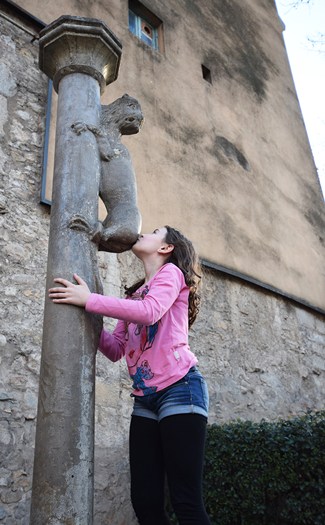
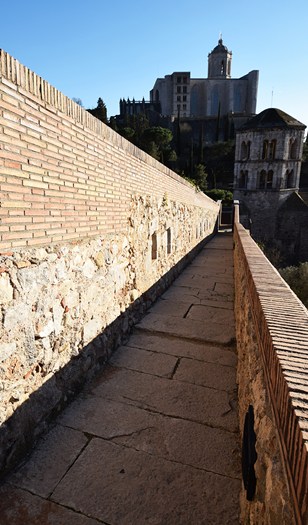
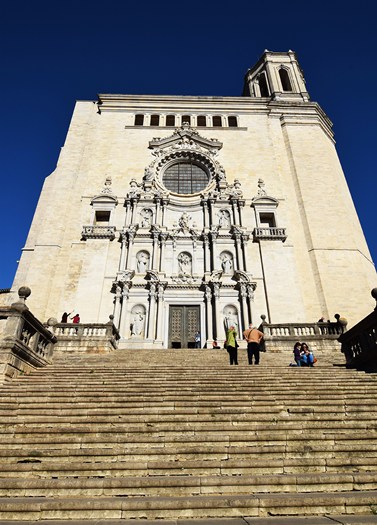
Left: Kissing the city mascot. Centre: Old Roman wall. Right: The Cathedral of St. Mary.
There is certainly much to like about this city tucked away in the northeast corner of Catalan, starting with its colourful homes, which reflect so brilliantly in the rivers — Ter, Onyar, Galligants and Güell — and supply visitors with lots of picture postcard moments to take home.
“You cannot take a bad picture in Girona,” says the guide.
The city is split in two sections with the historic Old Quarter located on the east side where houses are built so close together that in some streets it’s difficult to stretch out your arms.
“There’s a reason why the homes were built so close,” says Aicard as he leads me into the historic Jewish ghetto where Jews no longer live. “The Jews of Girona were always being persecuted so to avoid capture they would jump from one house to another.”
The Jewish community actually flourished in Girona during the 12th century and one of the most important Kabbalistic schools in Europe was based here.
However, in 1492, the same year Christopher Columbus set sail for the Americas, the Catholic Monarchs expelled all Jews from Catalonia and Girona’s Jewish ghetto, or Call, emptied. Many of Catalonia’s Jewish population immigrated to Holland where they prospered.
“Sadly the Jews never returned to Girona but they left a rich history behind,” says Aicard as we reach the entrance to the Jewish Museum, where artifacts from as far back as the 9th century are displayed.
As we walk through the Old Town’s narrow streets, Aicard tells me that Girona has endured “25 sieges over its history” and has been occupied by foreign forces — Napoleon’s troops among them — seven times.
“You see, everyone wants to live in Girona,” smiles Aicard as we turn a corner and a massive church comes into view.
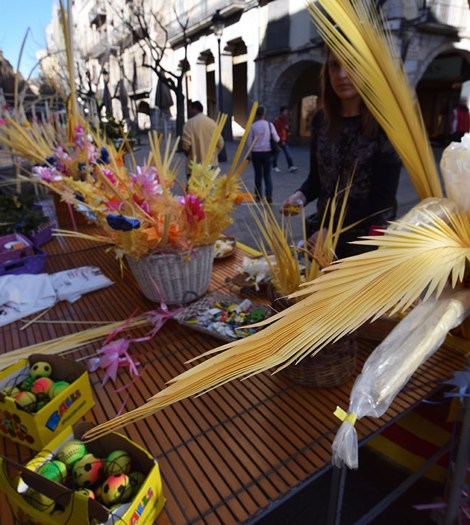
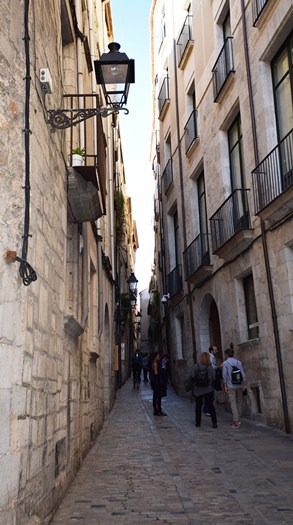
Left: Girona is a city of festivals and parties. Right: The Jewish Quarter has lots of history.
The Cathedral of Saint Mary of Girona is one of the most impressive churches I’ve ever seen. Its interior includes the widest Gothic nave in the world, a width of 22 metres and the second widest overall after St. Peter’s Basilica.
It dates back to the 11th century and was first designed in Romanesque style but later hints of Gothic architecture began to appear. Only the cloister and bell tower remain from the original Romanesque design, though.
A previous cathedral that stood on the same spot was used by the Moors as a mosque and after their final expulsion it was entirely rebuilt.
Another impressive church in town is Sant Feliu, a collegiate church which sits overlooking the river Onyar. Its lovely architectural style is 14th-century Gothic and it is one of the few Spanish churches that possesses a genuine spire. It contains, besides the sepulchre of its patron and the tomb of the valiant Álvarez, a chapel dedicated to St. Narcissus, who, according to tradition, was one of the early bishops of the Holy See.
Not far from the main cathedral we discover the remains of the city’s19th century defensive wall. Called the Passeig de la Muralla, it forms part of the tourist route that snakes through the Old Town. From the top of the wall we get a spectacular view of the cathedral and the surrounding neighbourhoods.
In recent years, Girona has become a hub for low-cost European airlines but the passengers rarely stay and explore the historic city.
“They’re in a rush to get to Barcelona but Girona is the best city in Catalonia — they don’t know what they’re missing,” says the home boy Aicard.
“Before leaving,” Aicard tells me, “you must partake in a Girona tradition and kiss the ass of our lion.”
The Leona de Girona is a mythical character that clings to a poll in a square across from Sant Feliu. It’s said that if you kiss the creatures backside, you’ll be guaranteed a return trip to this colourful city.
Judging by the long lineup waiting to plant a kiss on the Leona de Girona’s bottom, it’s obvious most people want to come back.
Information
One of the best times to visit Girona is in May when the city holds its annual Festival of Flowers. The whole city comes to life with colourful floral displays and monuments, courtyards and urban locations are transformed into unique ornamental gardens. / The most convenient way to get to Girona from Barcelona is by Renfe. Renfe trains run to and from the Barcelona-Sants station around every half hour. You could also opt to hop aboard an AVE high-speed train, which will get you to Girona in just over half an hour. For schedules and pricing, go to
www.palacetours.com/renfe/ / If you are interested in booking a Eurail Pass, go to
www.eurailgroup.org/eurail-vendors / For information on Barcelona, Girona and the rest of magical Catalan, go to
www.catalunya.com
About the Author
Marc Atchison is a veteran journalist and a seasoned traveller with more than 20 years of travel writing experience. As the former Travel Editor of the Toronto Star, Canada's largest newspaper, and now Editor-in-Chief and Senior Writer for TraveLife magazine (Canada) and travelife.ca, Marc has been to over 100 countries in the world. Japan is one of his favorite destinations and he's been there on numerous occasions.